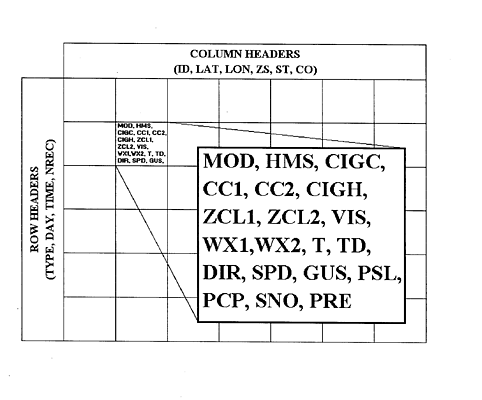



MD files normally contain observational data for a specific time period, for example, a day or an entire year. MD files store the data in individual records for a specific location at a specific time. Each MD file contains individual records. A record contains observational data for a latitude and longitude at a specific time. For example, one record may include measurements of temperature, dew point, wind speed, wind direction, and sea level pressure at 15 UTC for Houston, TX. A single MD file may contain thousands of records.
MD files use the naming convention MDXXnnnn where nnnn is a four-digit number. For example, MDXX0013 is the file name for MD file 13. Most McIDAS commands use only the MD file number. However, you must use the MDXX prefix with the DMAP command or when using Unix commands to copy, move, or delete MD files.
MD files in the ISFC, IRAB, NGMMOS, SYN, ETAMOS, and GFSMOS schemas are arranged in a table of rows and columns as shown in the ISFC example below. Time and day information common to all records in the row appears in the row header. Similarly, a column header designates common information according to location. Therefore, all the records along a particular row represent the same time and all the records down a particular column are reports from the same location.
MD files in the IRSG, ISHP, and PIRP schemas have row headers,
but not column headers because the reporting location changes.

| Schema | MD files | Data for day 158 is in MD file: | (ADDE Dataset) |
| ISFC | 1-10 | 8 | RTPTSRC/SFCHOURLY |
| IRAB | 11-20 | 18 | RTPTSRC/UPPERMAND |
| IRSG | 21-30 | 28 | RTPTSRC/UPPERSIG |
| ISHP | 31-40 | 38 | RTPTSRC/SHIPBUOY |
| NGMMOS | 41-50 | 48 | RTPTSRC/FOUS14 |
| SYN | 51-60 | 58 | RTPTSRC/SYNOPTIC |
| PIRP | 61-70 | 68 | RTPTSRC/AIRCRAFT |
| NLDN | 71-80 | 78 | RTPTSRC/LIGHTNING |
| WPRO | 81-90 | 88 | RTPTSRC/PROFHOURLY |
| WPR6 | 91-100 | 98 | RTPTSRC/PROF6MIN |
| NAMMOS | 101-110 | 108 | RTPTSRC/ETAMOS |
| GFSMOS | 111-120 | 118 | RTPTSRC/GFSMOS |